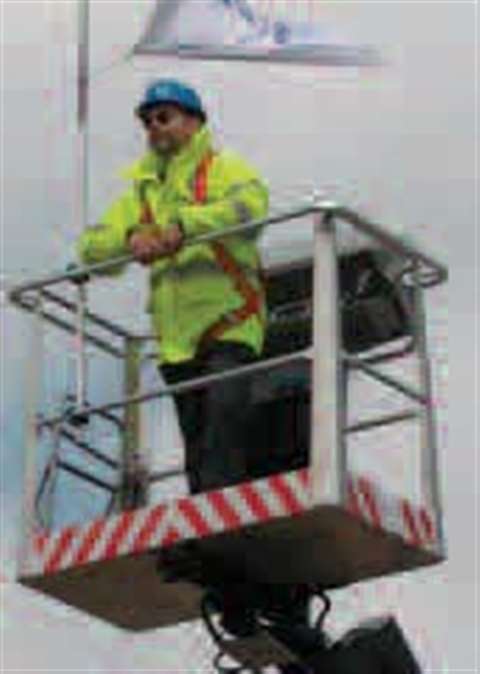Save lives
01 May 2008

There are too many users of mobile elevating work platforms who are simply not in the habit of wearing safety harnesses. If they understood the risks that they were taking, they would certainly use them. The simple fact is that harnesses save lives.
That is why the International Powered Access Federation (IPAF) published in May its Technical Guidance Note H1/05/05, recommending the use of full-body harnesses to be worn with the lanyard adjusted as short as practically possible for users of telescopic boom type platforms.
The principal risk for users of telescopic boom lifts is being ‘bounced’ out of the basket, particularly when travelling. Unexpectedly uneven or soft ground or going over a cable can cause the boom to vibrate and possibly throw the operator out. The other major cause of operators falling from baskets is when a boom type MEWP is struck, or just clipped, by another, passing vehicle. This is a particular hazard on busy construction sites, or working alongside live highways.
It should be emphasised that aerial work platforms are fundamentally safe, but accidents do happen.
IPAF emphasises that lanyards should be worn short-in fall restraint mode (also called work restraint)-to stop the operator coming out of the basket. A lanyard set longer offers fall arrest, but not fall restraint. The lanyard serves the purpose of catching the operator before they hit the ground, rather than keeping them in the basket.
The first problem with fall arrest equipment is that the basket has to be high enough to allow the lanyard time to work, especially those types which flex to cushion the impact of the harness taking the falling load. The second problem is that an operator hanging from the basket has to be rescued quite quickly. Within 20 minutes blood flow can start to be affected by the harness. The third, and potentially greatest, danger with fall arrest is that the shock loading on the platform can be enough to tip it over, injuring (or worse) both the fallen operator and whomever may be beneath. Therefore, it is best to prevent the operator falling out of the basket in the first place. Keep the lanyards short.
Proper equipment, proper use
IPAF recommends the full-body type of harness to protect the wearer. With a belt harness, a strong jolt can cause damage to the back and/or internal organs.
IPAF does not recommend, in normal situations, the use of harnesses and lanyards in scissor lifts or vertical platforms, primarily because they are not subject to the same risk of bouncing the operator out.
Lanyards can actually present a safety hazard on the deck of a scissor lift. If the lanyard is long enough to allow the operator to work around the platform (since scissor lift decks are generally larger than those on boom lifts), then by its very nature it presents a trip hazard. It also restricts the visibility of the operator of larger scissor lifts when driving at height unless they detach the harness each time they wish to reverse. Additionally, it is sometimes difficult or impossible to slide the deck out without disconnecting the lanyard. As the guidance note makes clear, a risk analysis should always be performed and its findings adhered to.
The importance of risk analysis cannot be over-emphasised, since there are always exceptions to general rules. Users of rough terrain, diesel-powered scissors should ensure they are harnessed and securely tied when travelling over bumpy ground or where-in the total absence of a safer alternative-they are compelled to lean out of the machine (something to be generally avoided at all costs). Conversely, risk analysis may lead the operator of a boom lift not to wear a harness if he or she is working over water. Depending on work height, machine configuration and other factors, falling freely into water may be a lesser risk than the machine falling into the water with the operator tied to it.
“Wearing a harness makes such good sense in boom lifts that I look forward to the day very soon when they are regarded as the symbol of the professional worker-at-height. Operators should regard them as a badge of office and a status symbol of their professionalism.”
IPAF's recommendations have been developed after extensive consultation with industry safety experts and with the UK Heath ' Safety Executive (HSE). The HSE also supports IPAF's recommendation that harnesses do not need to be worn in mast climbing work platforms.
Although the guidance was drafted specifically to comply with UK regulations, we regard it as best practice wherever you are working in the world. However, IPAF offices in the USA, Italy, France, Germany and Switzerland are consulting with national safety authorities to confirm that there is nothing in the various national regulations that present any conflict with what we are saying.
I am happy to report that the guidance note has been warmly welcomed by non-specialists who have been crying out for simple, clear guidance on this issue.
Wearing a harness makes such good sense in boom lifts that I look forward to the day very soon when they are regarded as the symbol of the professional worker-at-height. Operators should regard them as a badge of office and a status symbol of their professionalism.






